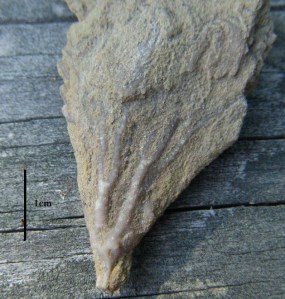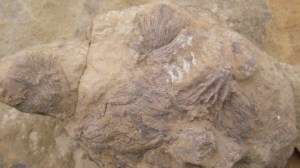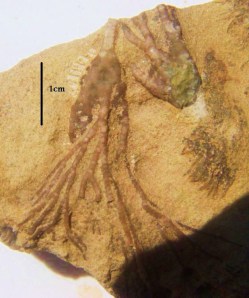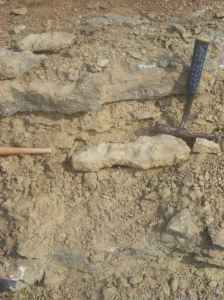Upon returning to the Bluegrass region of Central Kentucky a couple of years ago, the first outcrop that I planned to visit was the type section for the Millersburg mb. of the Lexington Lm.
Generally, though out the Late Ordovician, most of the Laurentian margins were experiencing transgressive sequences, but here, regressive shoal complexes associated with deep-seated tectonics produced the carbonate clastics common to the area.
The Lexington Lm. is a complex assemblage of limestone and shale facies where the changes can be abrupt-both laterally and vertical. The formation is generally a transgressive sequence that grades upwards into the deeper water limestone and shales. However, in the inner-bluegrass region, the Tanglewood and Millersburg members are an exception to the transgressing sea sequences.
The Tanglewood is a thick sequence of coarse-grained calcarenites with local unconformities and tidal influenced structures; many of the beds are cross stratified(The header for the blog is one of those sequences).
The Millersburg is typical of the complex facie relationships of the region. It inter-tongues with the other members of the Lexington above and below, and in some places, it is absent; it isn’t even consistent within its own framework. Drive a few kilometers down the road, or climb/ descend a few meters in the column, and the fauna/lithology changes. The Millersburg is nodular limestone and shale that was deposited above the wave base.
But, I love it! The Millersburg is one of my favorite members of the Lexington Limestone. It is the unit in which I found my first trilobite, and one of my first crinoids. While, it is more known among local invert geeks for the common fossils found in its beds, there are some beds that produce spectacular finds(if you read this blog, you will notice that most of the stuff contained in it is from the Millersburg).
So, back to the start of the post. Driving out Main Street, I noticed that those nefarious engineers had widened the road. It used to be a nice drive in the country; now it is a four lane highway with a median and shoulders to park your vehicle if it decides to quit working. That sent shudders up my spine! Then, as I approached the type section, my heart fell out. It was gone!
The type section gone? How could it be? Perhaps it was ignorance; maybe the reason was economic? Who knows? But, It was gone!
Unfortunately, the destruction of significant geologic treasures is common. I have to assume that the reason is ignorance… how many engineers could know the significance of what they are destroying when they plan their construction projects?
My favorite outcrop was no more. Oh well! One has to move on, and so, I did. About a kilometer down the road, and a 10 or so meters down in the column, there was a tongue of Millersburg sandwiched between some shallower stuff of the Tanglewood mb.
On one of my first visits to the site, I found a nice Pychnocrinus sp., but I didn’t find the bed that it came from. It was located in the float at the base of the outcrop.
width of photo about 10cm

With this clue, my latter visits to the site were spent in the area where I found that little cutie. At first, I wasn’t having a lot of luck locating the bed in which the crinoid was from, but then I climbed a little up in the column, and perched at the edge of a ledge, I found this large pinnate structure.
width of photo about 12cm

Just above the ledge was a bed of clay that pinched out a couple of meters in both directions. That small bed has produced over 40 crinoids in just the face of the bed.
Curiously, a lot of the crinoids appear to be severely weathered… even when pulled fresh from the rock. The rapid changes in lithology-vertically- is thought to be a result of changes in sea level due to tectonic forces related to the Taconic Orogeny. The bed might represent a paraconformity where a small uplift drained the area resulting in the bed’s exposure.
Pychnocrinus (?)

This is one that I found recently. microscope stage for scale

Calyx encrusted by a bryozoan(I’ve never seen this before)
width of photo about 20 cm

Lots of partials(you know the scale by now)


Some are hard to recognize, at first



I have prepped a lot of the crinoids, and some have turned out, nicely. I’ll put some of those up in the future.
Further reading and references:
Contributions To The Geology of Kentucky: Ordovician System
From the Cincinnati Arch to the Illinois Basin: geological field excursions
LITHOSTRATIGRAPHIC FRAMEWORK OF THE TANGLEWOOD BUILDUP, LEXINGTON LIMESTONE (UPPER ORDOVICIAN) OF THE BLUE GRASS REGION, CENTRAL KENTUCKY
Sequence stratigraphy and long-term paleoceanographic change in the Middle and Upper Ordovician of the eastern United States
Extinction, invasion, and sequence stratigraphy: Patterns of faunal change in the Middle and Upper Ordovician of the eastern United States






































































